Grow bags are not only a good alternative to traditional plastic pots but also make it simple to carry plants from one location to another. If you are looking for the best 10 gallon grow bags, your search ends here!
Read this article for all the basic information from top picks and features considered for taking care of your grow bags. we have got it all covered. Let’s dive into details and reach the verdict!
Contents
Best Grow Bags For Your Garden
Photo | Product | Material | Size | Drainage | Durability | Additional Features |
Nonwoven Fabric | 10 Gallon | Multiple Holes | Strong | Include Four Loops | ||
Nonwoven Fabric | 10 Gallon | Holes at Bottom | Optimal | Breathable | ||
Nonwoven Fabric | 10 Gallon | Seamless | Medium | Reinforced Handles | ||
Poly- propylene | 10 Gallon | Built-In | Very Strong | Washable |
1. VIVOSUN 5 Pack 10 Gallon Square Grow Bags
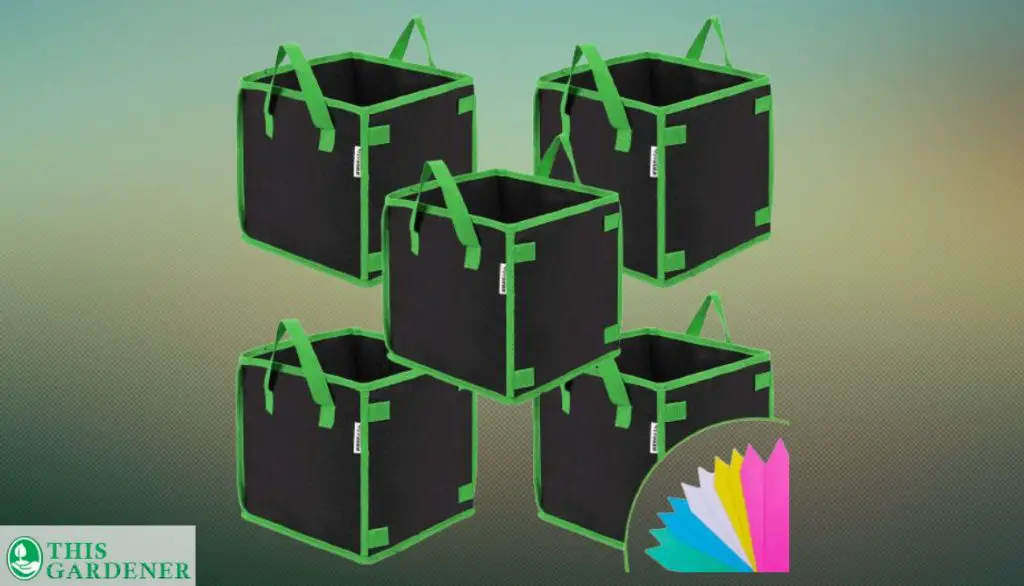
Special Feature: | Durable |
Shape: | Cylindrical |
Mounting Type: | Inside Mount, Outside Mount |
Product Dimensions: | 17" x 12" (43cm x 30cm) |
Weight: | 2.01 pounds |
The VIVOSUN 10-gallon grow bags are manufactured from a durable non-woven fabric and come with reinforced handlebars for easy transport. These grow bags have a features:
- The depth and diameter of 13.4 inches, making them suitable for housing a variety of root vegetables such as spinach, radishes, and peppers.
- You can also cultivate plants like flowers and herbs with their help.
- Each bag has four loops that are designed to accommodate sticks or poles in order to provide stability for greater plant vigor as they grow.
- The nonwoven fabric of the bags allows for adequate drainage, and the soil can be appropriately carbonated with this set, and these bags are usually sold as a set of five.
- 10-gallon size allows ample space for plants to grow
- Puncture-resistant material can withstand multiple seasons of use
- It has several small holes for better drainage and aeration
- The pack of five grow bags is a cost-effective option
- Not suitable for larger plants or trees
- Possible loss of shape if stakes are not used
2. OPULENT SYSTEMS 5-Pack 10 Gallon Grow Bags
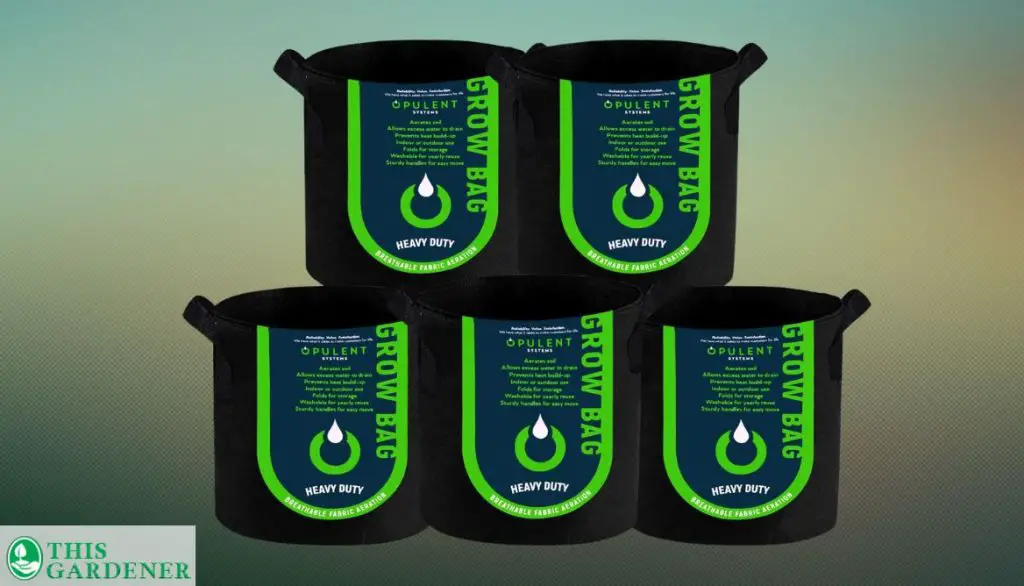
Special Feature: | Drainage Holes |
Shape: | Square |
Mounting Type: | Inside Mount, Outside Mount |
Product Dimensions: | 16" x 16" x 12" |
Weight: | 2.84 pounds |
These five, 10-gallon grow bags from OPULENT SYSTEMS are largely made up of a nonwoven fabric that provides for adequate airflow and drainage of excess water. They have next features:
- Include strengthened handles, which make it much simpler to carry the bag around.
- Have a depth of 12 inches and a diameter of 17 inches.
- Can be reused and washed, and since they allow for enough aeration of the soil, they are resistant to damage caused by mold and humidity.
- Tomato plant, eggplants, and herbs, which do not require a significant amount of room for their root systems, benefit from being grown in bags of 10-gallon size.
- Lightweight and portable
- They can be used indoors or outdoors
- Made of a variety of materials
- Prevent over-watering
- Promoting healthy root ball growth
- Used for a variety of plants
- Not much durable as traditional pots
- Does not provide much insulation
- They dry out more quickly
3. Nicheo 3 Pcs 10 Gallon Transparent Grow Bag
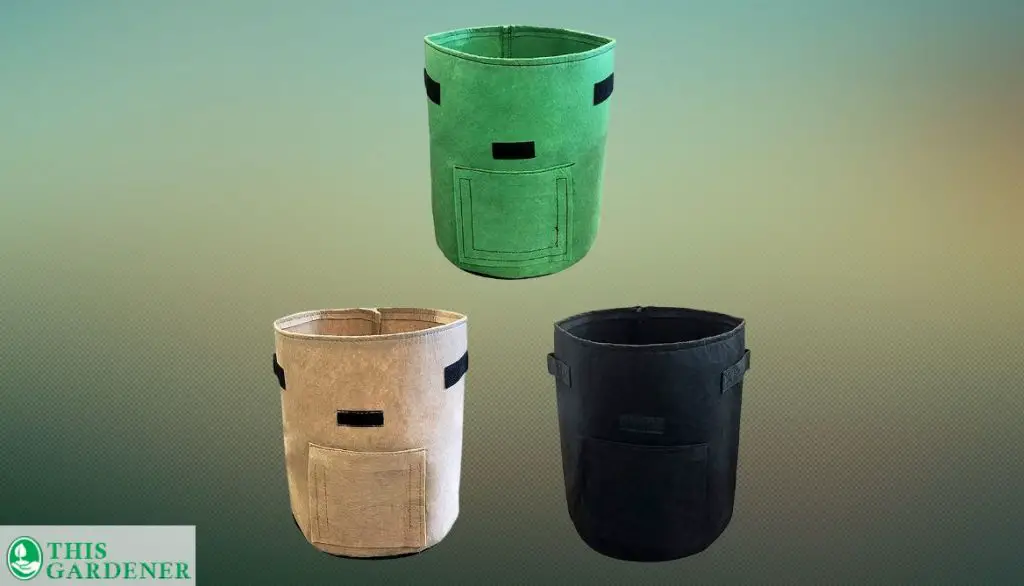
Special Feature: | Handy |
Shape: | Cylindrical |
Mounting Type: | Inside Mount, Outside Mount, Window Mount |
Product Dimensions: | 13.78"D x 13.78"W x 17.72"H |
Weight: | 1.43 pounds |
Through the glass on this 10-gallon grow bag, gardeners can observe the development of their root crops. There are other great features:
- The cover of the window is held with a hook-and-loop fastening that may be opened to allow gardeners to pick vegetables via the window’s entrance.
- The nonwoven fabric of these three-pack grow bags allows for soil ventilation.
- The bags have strengthened side handles, yet the handles do not extend very far, creating a seamless impression. These bags are available in black, brown, and green colors.
- Cost-effective solution for growing plants in an indoor or outdoor garden.
- Transparent material allows for easy plant monitoring
- The 10-gallon size is suitable for a variety of plants
- These are durable grow bags with UV-protected material
- The bags are not reusable
- The transparent material may not provide enough insulation
4. JERIA 12-Pack 10 Gallon, Vegetable/Flower/Plant Grow Bags
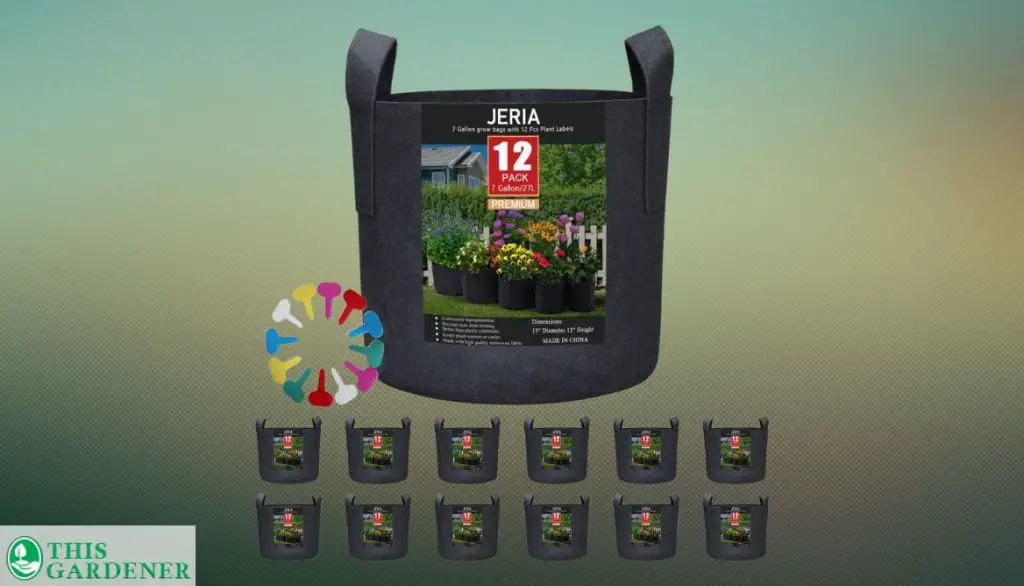
Special Feature: | Drainage Hole |
Shape: | Round |
Mounting Type: | Inside Mount, Outside Mount |
Product Dimensions: | 16" x 12" (40cm x 31cm) |
Weight: | 4.2 pounds |
Each JERIA’s 10-gallon grow bag has a dimension of 16 inches by 12 inches, and there are the standard features:
- They come with reinforced handles.
- Bags are made out of nonwoven fabric, so the soil within may breathe and drain properly.
- Even when loaded with dirt, the bags remain manageable because of the inclusion of sturdy handles and the robust nature of the material from which they are constructed.
- This pack of 12 bags also includes 12 plant tags that may be used to identify the plants within.
- These bags are reusable and may be washed after each use.
- These 10-gallon bags are an excellent choice for plants that require a great deal of room for their roots, such as melons, indeterminate tomatoes, squash, and even tiny fruit trees.
- A good option for people who like to change up their garden layout more often
- Space-saving: can grow plant in small garden space or on balconies and patios
- Allows for good drainage, helps prevent root rot
- Includes plant tags for labeling each bag’s contents
- These grow bags have a limited lifespan of one or two growing season
- Hot summer sun can cause damage to the health of the plants
How We Chose The Best Grow Bags?
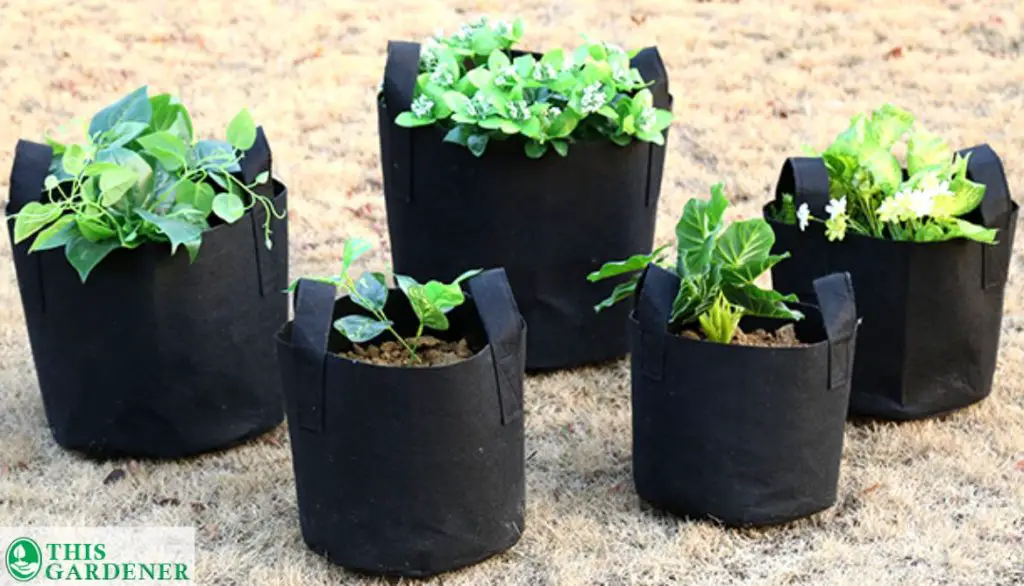
Choosing to grow bags to grow certain plants can be a hefty task. One can not look at all the bags at once. Why take the hassle when have already done it for you? Read below to find out how we chose each grow bag:
1. Researched
We found out that grow bags are only effective if they are made of a material that allows air and moisture to circulate and escape, preventing water from pooling around the plant roots.
As a result of these design options, grow bags can be a little fragile; thus, we researched options that should be able to hold their shape under the weight of soil and plant.
2. Looked For Different Sizes
One advantage of using a grow bag is that it’s easier to transport a plant around. A lot of the options here have sturdy handle straps on the side to hold. The optimal size for a garden relies on the individual plants and the available growing area.
We made a note if a bag was too small for growing substantial root veggies but adequate for transplants or annual herbs.
3. Noted Added Features
These Nicheo 10-gallon bags, for example, contain a window, which is a nice added feature. Seeing if root crops like potatoes and carrots are ready to be harvested is a fantastic tool to have, but it’s not essential.
As an added bonus, it can help keep youngsters engaged in gardening by giving them a sneak peek at what’s happening underneath the surface.
What to Consider When Choosing The Best Grow Bag?
What you intend to grow should be your first consideration before buying grow bags. Here are some of the most important factors to think about while selecting a grow bag.
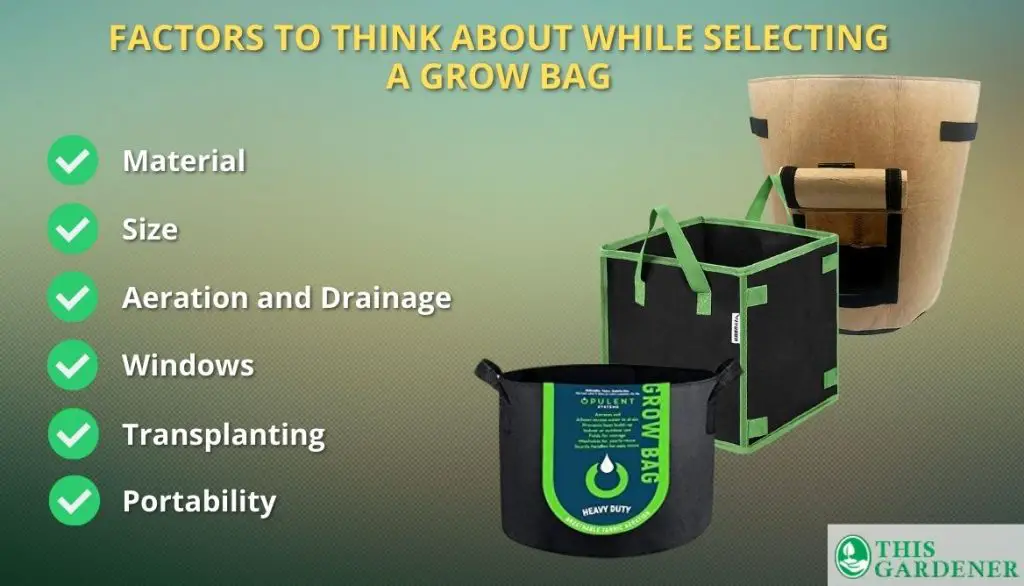
1. Material
Commonly used grow bags are crafted from nonwoven fabric, which is bound together using heat or chemicals. Nonwoven fabric bags are superior to woven fabric bags in terms of breathability, therefore it’s perfect for use in grow bags.
This ensures that the soil and plants within can dry out between watering. Mold may be prevented, at least to some extent, by ensuring enough air circulation.
The most effective grow bags are crafted from a nonwoven material that is both permeable to air and strong enough to hold the plant’s soil and its weight.
2. Size
When looking for the finest grow bag, size is a key factor. The sizes of grow bags range from one gallon to well over twenty. One tomato or pepper plant may be grown in the largest capacity of the grow bags on this list, which is 10 gallons.
What you plan to grow in your bag will determine which choice is ideal. Tomato plants, for instance, need at least 12 inches of soil, whereas radishes only need around 6 inches.
3. Aeration And Drainage
A good grow bag will include holes in the bottom to let water out and air into the soil, both of which are essential for strong root development. The advantages of grow bags include excellent aeration and drainage compared to planting in the ground.
Repeated use increases with a grow bag’s ability to drain water and dry out. Bacteria and mold can flourish in grow bags that don’t drain properly.
4. Windows
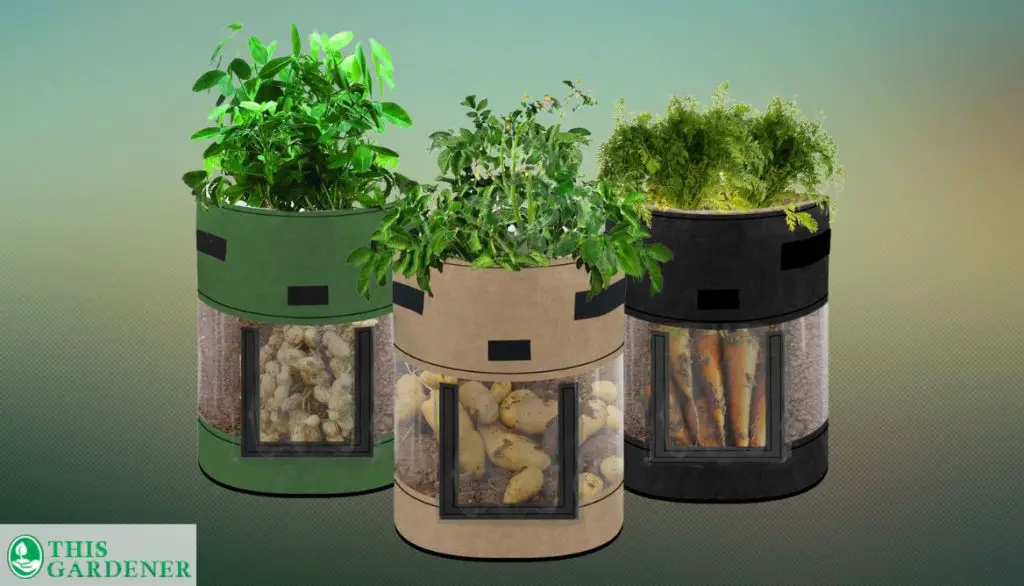
Some varieties of grow bags have transparent plastic “windows” that allow gardeners to check on their plants’ progress by observing the depth of their roots. Carrots and potatoes benefit greatly from these.
Vegetable harvesting can be simplified by installing an operable window. A window may be helpful for growing root vegetables, but it isn’t typically required when growing flowers or herbs.
5. Transplanting
If you are going to grow plants or seeds in grow bags with the intention of transplanting them later, you should seek to grow bags that have a hook-and-loop closure on the side of the bag.
It is far simpler to remove a plant by simply undoing these closures than it is to invert the bag and work the plant free from its container.
Container gardening is good for any flower, herb, or root vegetables that won’t survive the whole gardening season. This is because the plants can be removed simply in order to bring them indoors, which is another benefit of container gardening.
6. Portability
The ability to be transported easily is also crucial. The sturdy handles on the majority of grow bags make them convenient to transport. Don’t try to get around not having enough room by purchasing grow bags that are too tiny for the flower or root veggies to be planted.
Smaller grow bags are easier to transport since they require less soil, but they may not be as accommodating to larger plants like indeterminate tomato varieties.
Plastic Pots Vs Grow Bags
While both plastic pots and grow bags may be used to cultivate plants, these two containers are differentiated in several important ways.
Plastic Pots
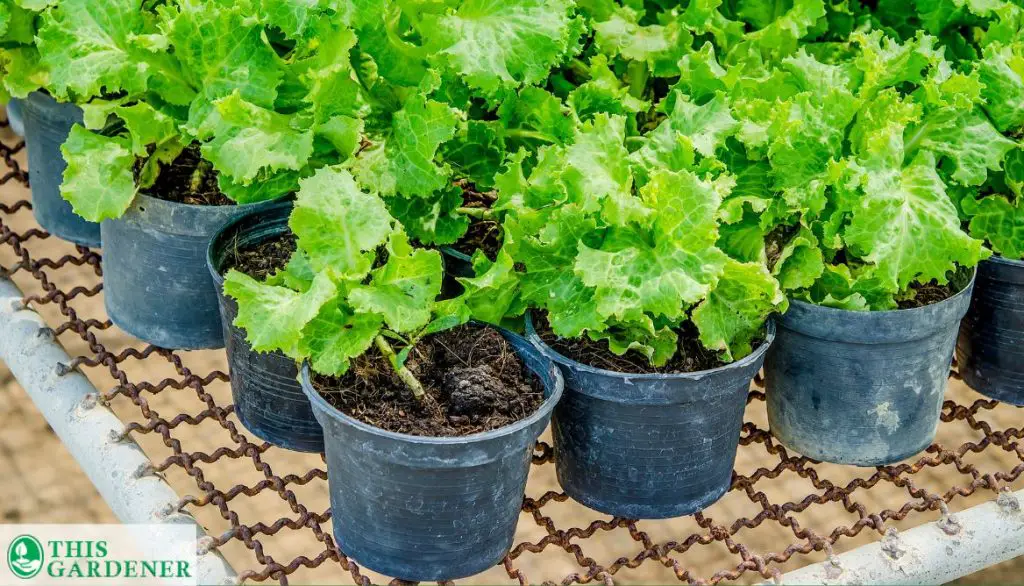
Let’s have a look at the pros and cons:
- Long-lasting and versatile
- Modular designs
- A wide range of plant sizes is easily accommodated
- Increased airflow and excellent drainage
- The porous and permeable material
Grow Bags
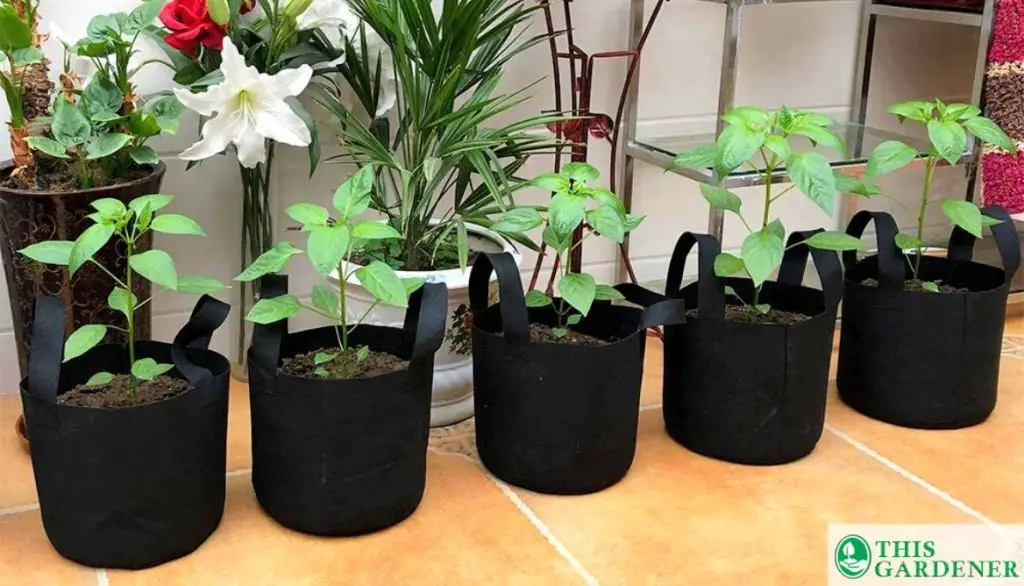
Have a glance at the pros and cons:
- Breathable fabric material
- Better air circulation and water flow
- The soil drains well for both faster growth and preventing issues like root rot
- More compact
- A good option for small spaces
- The best option for starting seedlings
- Only typically disposable
- Can’t be reused multiple times
Why Is Grow Bags Good For Healthier Plants?
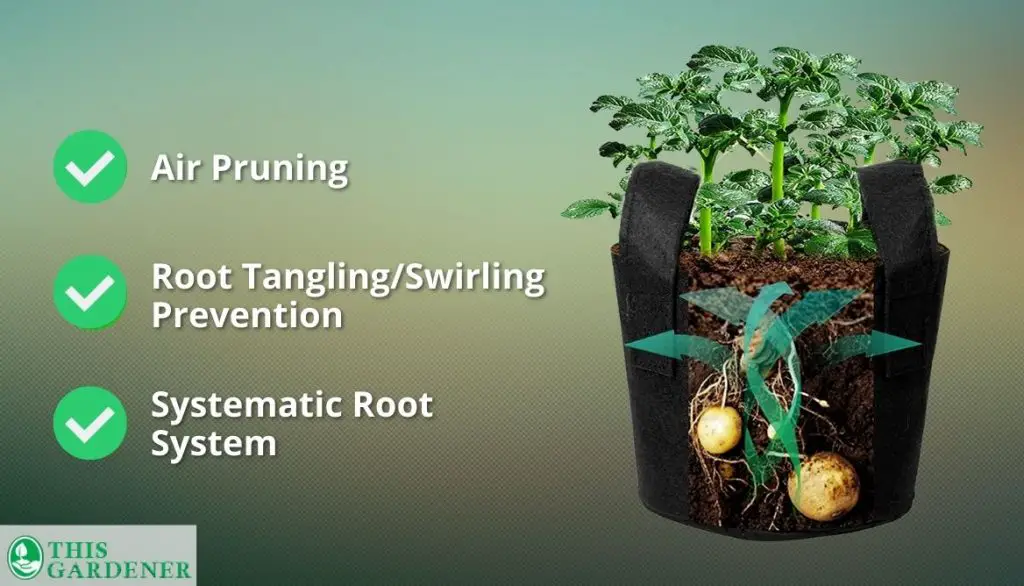
Below are some of the key points that make grow bags the best choice:
1. Air Pruning
One of the main advantages of using grow bags is air pruning, but to appreciate their worth, it is necessary to understand what might happen to plants when they are grown in conventional plastic pots. If you leave a plant in a plastic pot, the roots will eventually grow to the bottom of the pot, where they will rot.
2. Root Tangling/Swirling
The plant loses its orderly root structure and is unable to effectively avoid root swirling. With time, the roots in the bottom of the pot may take in too much water, and the plant will be unable to absorb as many nutrients as it needs. For this purpose, you can use grow bags.
3. Systematic Root System
More air may enter the soil around the bag’s borders when it’s breathable, which is why these bags are so useful. When a plant’s roots grow out into the soil, they detect air and perish.
This causes the plant to develop a more systematic root system that expands outward from the center of the container into the surrounding soil.
A plant’s health and productivity would benefit from this design because of how efficiently water and nutrients would be absorbed.
Where Can You Use These Grow Bags?
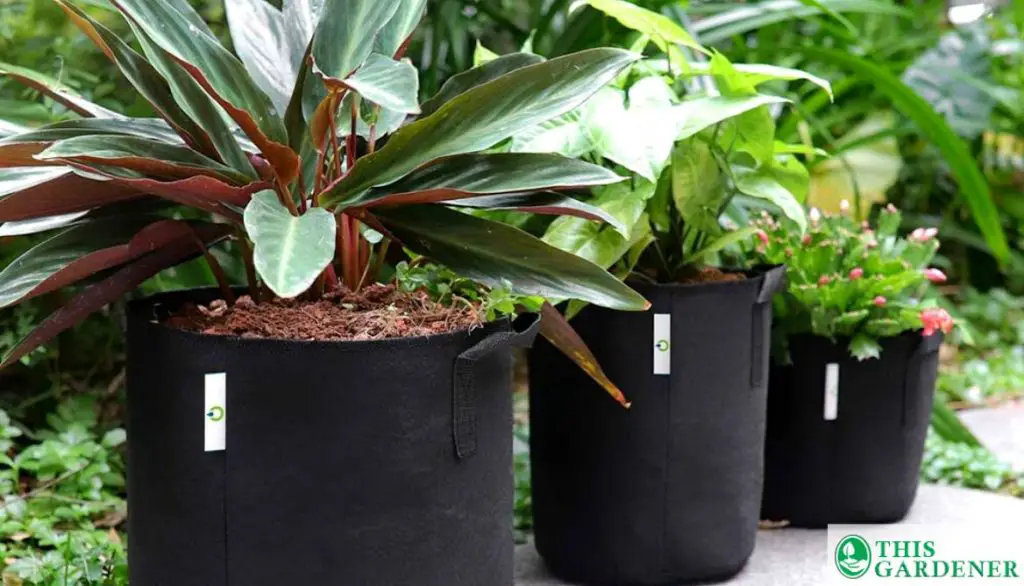
Grow bags are very handy and small in size. They can be used almost anywhere you like. But, there are few places in your home where these grow bags will look more suitable. Such as:
1. Small Garden Or Patio Or Deck
The fact that it can be used almost everywhere, even in urban areas with no available land, is a big selling factor for this grow bag approach. Almost any plant is suitable for growing in a bag, so you can take your small garden from the porch to the deck or patio.
2. Lawn
You may still put them on your lawn, as placing outside plants in bags is a perfectly acceptable way to regulate the nutrients. To what extent, though, may they be used indoors? To be specific, you’ll need a tray or container with a base large enough to collect the water that will be draining.
3. Outdoor Under Sunshine
In addition, this container should be emptied on a regular basis, since standing water can be harmful to plant health. Therefore, it is suitable for use in a grow tent.
Indoor gardening is no different than outdoor gardening in this regard; you’ll need to position your plants so that they receive adequate direct sunlight. It is important to research the light requirements of each plant species.
Taking Care Of Grow Bags

If you take good care of them, these grow bags will last for many seasons. Careful handling not only preserves the integrity of the bags but also prevents young plants from being damaged by toxins in older soil.
Hosing
Taking the necessary precautions is simple. First, when you’ve finished using them, give them a good hosing down with the garden hose. After hosing, wait for them to dry completely before wiping away any lingering dirt or plant debris.
Remove Impurities
Run the items through the washing machine with baking soda and white vinegar to ensure that all traces of chemicals and other impurities have been removed. Use the “heavy soil” cycle and repeat washings to ensure all traces of dirt and grime are gone.
Drying
Last but not least, make sure to air dry them completely before storing them away. There is a risk of mold growth if moisture is allowed to stay.
Our Verdict
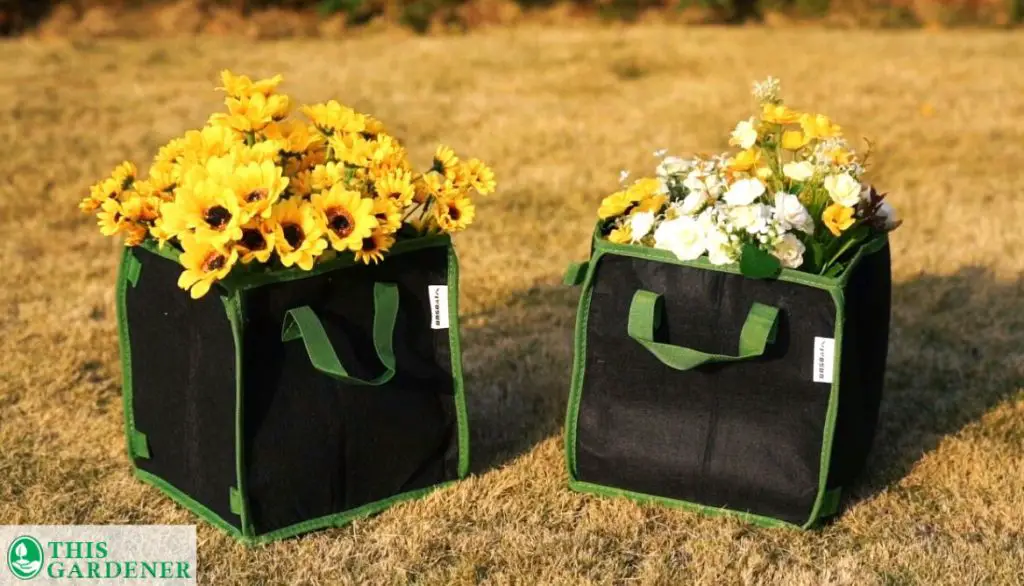
Grow bags address a need that is common among those who cultivate plants at home, particularly those who grow food. These soft bags are great for making use of limited storage space since they can be folded up and stashed away until they are required again.
VIVOSUN 5-Pack of 10-Gallon is our favorite because of the:
- Nonwoven fabric material
- Allows excess water to escape
- Smooth air circulation
- Assists even inexperienced gardeners in cultivating flowers, herbs, or vegetables
FAQ
Which Brand Grow Bag Is Best?
VIVOSUN, OPULENT SYSTEMS, Nicheo, and JERIA are among the few best grow bag brands. These brands are currently in high demand within the market.
How Big Is A 10-gallon Grow Bag?
Grow bad sizes differ for each brand and make. However, the ideal size for 10-gallon Grow Bags is 16.6 inches in diameter and 13 inches high when filled.
How Many Plants Can You Put In A 10-gallon Grow Bag?
It is possible to cultivate two or three plants in a grow bag that holds a size of 10 gallons.
Can I Use Ikea Bags As Grow Bags?
Ikea bags are made from durable and heavy-duty polypropylene material. This material can be used as a grow bag, but it’s important to note that it is not breath.able, which means that it will not allow for proper air and water flow.
Which Material Is Good For Grow Bags?
The finest grow bags use a polypropylene felt-like fabric that enables air pruning and is very breathable. Fabrics should be tested for the absence of bisphenol A (BPA) and be approved for use around food.
Conclusion
Grow bags for plants are not only convenient but also an excellent resource for extended experimentation for garden enthusiasts. Those who desire to cultivate their own vegetables but lack the space to do so may consider purchasing these products.
For how many years you have been a gardening lover? And which plants do you want to grow in these 10-gallon bags? Share your journey as a garden affectionate with us in the comments section below as we would love to hear it out from you!
- How to Get Potatoes to Sprout Eyes: Detailed Growing Guide with 3 Options - July 31, 2023
- Weight of a Medium Potato: Revealed in Detailed Guide - July 29, 2023
- Maris Piper Potatoes: 9 Substitutes You Should Know About - July 27, 2023
Hello! I’m Jessica Zander, a garden coach and consultant based in the Boston area (zone 6b), offering virtual consultations across the country and Canada.
I’ve been passionate about gardening since the early 1990s, and in 2022, I launched You Can Do It Gardening to empower individuals to feel more confident in their gardening endeavors.
Following a 30-year career in nonprofit finance and operations, I transitioned out of that field in mid-June of 2023 due to the growing demand for coaching services. Interestingly, my years of presenting financial statements to boards and finance committees proved to be valuable experience for teaching people about gardening! I enjoy sharing skills, providing guidance and suggestions, and collaborating efficiently with clients to make significant improvements to their outdoor spaces, both small and large. I also regularly teach at the Arlington Continuing Education and Cambridge Adult Education.
My approach is direct and practical, akin to Mary Poppins, but tailored to your garden. Clients find satisfaction in saving money and taking pride in their own gardening achievements.

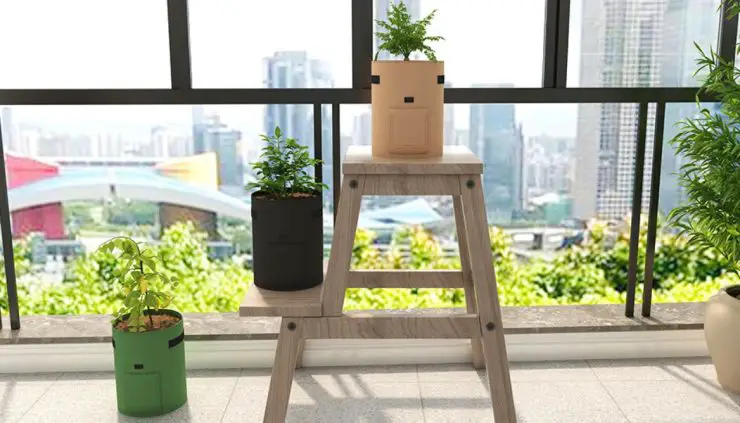





Add comment